Pelgrimeren is van alle tijden en iedereen © voor zoekers en sprokkelaars 
 © Alle King-weblogs over The Way of Saint James van Georgiana Goddard King bijelkaar: http://king-early-days.blogspot.com © http://king-renaissance.blogspot.com © http://pilgrimsplaza-king-index.blogspot.com © http://pilgrimsplaza-king-0.blogspot.com © http://pilgrimsplaza-king-1.blogspot.com © http://pilgrimsplaza-traplepuy.blogspot.com © http://pilgrimsplaza-king3.blogspot.com © diversen: http://pilgrimsplaza-ramiro-1.blogspot.com © http://pilgrimsplaza-peterspruijt.blogspot.com © http://seculierpelgrimsgenootschap.blogspot.com © http://pilgrimsplaza-gedichten.blogspot.com © http://pilgrimsplaza-boeken.blogspot.com ©
© Alle King-weblogs over The Way of Saint James van Georgiana Goddard King bijelkaar: http://king-early-days.blogspot.com © http://king-renaissance.blogspot.com © http://pilgrimsplaza-king-index.blogspot.com © http://pilgrimsplaza-king-0.blogspot.com © http://pilgrimsplaza-king-1.blogspot.com © http://pilgrimsplaza-traplepuy.blogspot.com © http://pilgrimsplaza-king3.blogspot.com © diversen: http://pilgrimsplaza-ramiro-1.blogspot.com © http://pilgrimsplaza-peterspruijt.blogspot.com © http://seculierpelgrimsgenootschap.blogspot.com © http://pilgrimsplaza-gedichten.blogspot.com © http://pilgrimsplaza-boeken.blogspot.com ©
home > http://pilgrimsplaza.blogspot.com © website PILGRIMSPLAZA > www.pelgrimspaden.nl © Nieuw: Home phpBB-forum >
http://pelgrimspaden.blogspot.com New http://the-santiago-enigma-clues.blogspot.com
and http://the-santiago-enigma-gateway.blogspot.com
Faces in the London Pórtico de la Gloria

All these faces are cut out of pictures of the plaster copy in the Victoria & Albert Museum at London of the Pórtico de la Gloria in Saint James's cathedral at Santiago de Compostela in Spain. Courtesy and © (permission given on 22-5-9) of Mr. Gareth Thomas who took al of these photos on the eve of his pilgrimage from England through France to Santiago. Also see
http://www.youtube.com/watch?v=Yz_kusZqrLQ .
 You may read more about the making of these pictures and Gareth's pilgrimage in Re: The Santiago Enigma by Gareth Thomas on March 29th, 2008, 11:37 pm on http://www.pilgrimage-to-santiago.com/board/miscellaneous-about-santiago/topic3794.html#p20890 .
You may read more about the making of these pictures and Gareth's pilgrimage in Re: The Santiago Enigma by Gareth Thomas on March 29th, 2008, 11:37 pm on http://www.pilgrimage-to-santiago.com/board/miscellaneous-about-santiago/topic3794.html#p20890 .
This was followed by reactions on The Santiago Enigma like:
http://www.pilgrimage-to-santiago.com/board/miscellaneous-about-santiago/topic3794-25.html#p21219 and
http://www.pilgrimage-to-santiago.com/board/miscellaneous-about-santiago/topic3794-25.html#p21968 .
You may notice first Daniel’s vivid and human face and then the spiritual and similar faces of the Christ in Majesty and both James’s (Major and Minor). These pictures make it obvious that Master Mateo had a purpose or a mission, if not a direct order from his bishop to create these clear similarities.
Did anyone ever read or hear about Mateo's iconographic program for the Pórtico de la Gloria at Compostela?
Nieuw!
Waat staat Sant iago eigenlijk voor?
Welke raadselen vragen nog om een oplossing?
Zie op het grote Santiagoforum te Santiago de Compostela:
The Santiago Enigma  by PILGRIMSPLAZA on March 21st, 2008, 6:00 pm op http://www.pilgrimage-to-santiago.com/board/miscellaneous-about-santiago/topic3794.html
by PILGRIMSPLAZA on March 21st, 2008, 6:00 pm op http://www.pilgrimage-to-santiago.com/board/miscellaneous-about-santiago/topic3794.html
Daarop is de hamvraag:
5. How jewish Jacobus became catholic James
Het antwoord is nog niet gegeven, dus wat let u…
"At Bryn Mawr Miss King became a tradition and a cult; now she is a legend." "Because this work is culturally important..." News! 'King' herdrukt (foto)
News! 'King' herdrukt (foto)
The Way of Saint James van Georgiana Goddard King (1920)
is recent in Santa Fe in Niew Mexico in de VS herdrukt en is nu ook op internet onbeperkt en in diverse leesedities voor een ieder beschikbaar. Voor een ongewijzigde fotografische herdruk (met nieuwe korte inleidingen), zie http://www.pilgrimsprocess.com/events.htm ; mijn bestelling deed er een week over.
Voor diverse tweedehands exemplaren van deze herdruk, zie onder meer http://www.alibris.com/booksearch?cm_sp=search-_-collectibles-_-na (of www.alibris.com )
Voor nog enkele antiquarische eerste drukken, zie bijvoorbeeld http://www.abebooks.com en zoek op auteur en titel of ga direct naar http://www.abebooks.com/servlet/SearchResults?an=georgiana+goddard+king&bsi=30&tn=the+way+of+saint+james&x=32&y=11&prevpage=1 waar je van de herdruk tientallen edities te kust en te keur vindt. Enkele originele eerste drukken uit 1920 staan onderaan op de laatste pagina.
‘King’ lag (of ligt?) ook te leen of ter inzage in de Openbare en de Koninklijke Bibliotheek (in het centrum respectievelijk bij CS) te ’s-Gravenhage.
Zie de volledige inhoudsopgave van alle drie King-delen hieronder op http://pilgrimsplaza-king-index.blogspot.com . Meer over en besprekingen op enkele King-weblogs onder www.pelgrimspaden.nl en op het grote forum te Santiago de Compostela ( http://www.pilgrimage-to-santiago.com ) in The Santiago Enigma by PILGRIMSPLAZA op http://www.pilgrimage-to-santiago.com/board/miscellaneous-about-santiago/topic3794.html#p20649 .
Op dat Santiagoforum is recent in reactie op Jacobus ook veel geschreven over zijn ‘concurrent’ Priscillianus; zie Pilgrimage to Heresy: Don't Believe Everything They Tell You  by Priscillian op http://www.pilgrimage-to-santiago.com/board/miscellaneous-topics/topic3554.html#p18832 . Ook een mooi geschreven boek!
by Priscillian op http://www.pilgrimage-to-santiago.com/board/miscellaneous-topics/topic3554.html#p18832 . Ook een mooi geschreven boek!
Meer informatie op: gatherings@americanpilgrims.com ; http://www.americanpilgrims.com ; http://www.backpack45.com/camino2.html ; http://www.pilgrimsprocess.com/events.htm ; magazine@americanpilgrims.com ; htttp://www.americanpilgrims.com/contact_us/contact_us.html ; http://www.americanpilgrims.com/events/events_national.html.com
Bijeenkomst  American pilgrims 2007 (!)
American pilgrims 2007 (!)If you were not able to attend, you can get some sense of what you missed by browsing through the beautiful program (PDF, 700KB): Pilgrimage to America - Gathering of Pilgrims - Williamsburg, Virginia - March 9-11, 2007 (!) http://www.americanpilgrims.com ; http://www.americanpilgrims.com/events/events_national.html
Some subjects from the program:
“Pilgrimage in Classical Greece and Rome”—Barbette Spaeth, chair of the department of classical studies at William & Mary, explores the modes of pilgrimage in traditional Greek and Roman religions with telling examples from Corinth, Egypt and throughout the classical world.
“Prayer and pilgrimage”—Rev. Michael Wyatt, Chair of American Pilgrims on the Camino, former Canon Theologian at the National Cathedral in Washington, DC, and now at St. John’s Episcopal Church in What does it mean to walk for spiritual reasons? What about religious reasons? Explore together what methods help us remain both open and focused as pilgrims.
“Pilgrims and Crusaders”—Phil Daileader, a nationally known authority on the Crusades, is also the scholar behind the distinguished lectures on The Early Middle Ages and The High Middle Ages from The Great Courses audio series. He received his doctorate in medievalhistory from Harvard University in 1996, and has been teaching at William and Mary since 1998. He specializes in the social and cultural history of Mediterranean Europe.
“Pilgrimage in the Islamic Tradition”—John Williams will speak on pilgrimage in the Islamic tradition, travel for transformation by a faith community which undertakes the hajj to Mecca as a sacred duty for every believer. John is professor emeritus of religious studies at the College of William & Mary and a specialist in the Islamic tradition. His books include The World of Islam, Themes of Islamic Civilization and Roman Catholics and Shi’i Muslims.
Next Step - 2008 (!) Gathering and Hospitalero Training - Mission Santa Barbara, Santa Barbara, California - March, 2008 (!) - http://www.santabarbara.com/points_of_interest/mission
Pilgrims on the Camino American - Our mission is to foster the enduring traditions of the Camino by supporting its infrastructure, by gathering pilgrims together, and by providing information and encouragement to past and future pilgrims. American Pilgrims continually seeks meaningful ways to support the Camino de Santiago de Compostela. info@americanpilgrims.com ; http://www.americanpilgrims.com ; gatherings@americanpilgrims.com or American Pilgrims on the Camino, Attn: Gathering, 1514 Channing Avenue, Palo Alto CA 94303, USA
Flip Books & reviews:http://www.openlibrary.org/details/wayofsaintjames01kinguoft Vol. I
http://www.openlibrary.org/details/wayofsaintjames02kinguoft Vol. II
http://www.openlibrary.org/details/wayofsaintjames03kinguoft Vol. III
http://openlibrary.org/details/wayofperfectlove00kingiala TWoPL
http://openlibrary.org/details/unpublishednotes00streuoft UNaRP
http://www.archive.org/details/someaccountofgot00streuoft SAoGAiS
http://www.archive.org/details/someaccountofgot02streiala Vol. II
http://demo.openlibrary.org/b/way_of_saint_james_2/review/1 MvH1 22-01-08 http://demo.openlibrary.org/b/way_of_Saint_James_2/review/2 PP2 16-01-08 http://demo.openlibrary.org/search?go=go&q=Georgiana+Goddard+King 18 titels http://pilgrimsplaza-king3.blogspot.com MvH 26-11-07
http://libro.uca.edu/sjc/sjc.htm text-on-line-book: 

R. A. Fletcher,
Saint James's Catapult: The Life and Times of Diego Gelmírez of Santiago de Compostela http://www.archive.org/details/roadtosantiago010125mbp The Road To Santiago, Pilgrims of St. James (1957) Walter Starkie, Flip Book
http://www.pilgrimage-to-santiago.com/2008/01/30/for-the-first-time-more-foreign-pilgrims-than-spaniards
 For the first time, more foreign pilgrims
For the first time, more foreign pilgrims [in Santiago de Compostela]
La Voz de Galicia reports today [January 30th, 2008] that for the first time since statistics where collected in 1985 that there are more foreigners receiving the
compostela than Spaniards. The article focuses on the fact that last year, 58.700 foreigners recieved the compostela and “only” 55 326 Spaniards. The articles also mentions that pilgrims from 121 countries received the compostela in 2007.
Geert BAKKER
PILGRIMSPLAZAwww.pelgrimspaden.nl Addresses >
Commentshttp://www.pelgrimspaden.nl >
http://king-early-days.blogspot.com (in English) & (the following in Dutch:)
http://king-renaissance.blogspot.com
http://pilgrimsplaza-king-index.blogspot.com (Index and Forword of The Way of Saint James)
http://pilgrimsplaza-king-1.blogspot.com
http://pilgrimsplaza-traplepuy.blogspot.com
http://pilgrimsplaza-king3.blogspot.com (mainly in English) http://pilgrimsplaza.blogspot.com Nieuws: 'King' is in de VS herdrukt als pocketbook en ook de eerste druk uit 1920 (foto) is nog verkrijgbaar! Mijn zending deed er nog geen week over. Iedereen kan nu dit verbijsterende en ontroerende meesterwerk op de eigen pc lezen en kopiëren. Doe mee aan de bespreking en meld u aan in het reactieformulier onderaan deze pagina.
Nieuws: 'King' is in de VS herdrukt als pocketbook en ook de eerste druk uit 1920 (foto) is nog verkrijgbaar! Mijn zending deed er nog geen week over. Iedereen kan nu dit verbijsterende en ontroerende meesterwerk op de eigen pc lezen en kopiëren. Doe mee aan de bespreking en meld u aan in het reactieformulier onderaan deze pagina.
Editorial Review op Amazon.com: Book Description - In Three Volumes. This scarce antiquarian book is included in our special Legacy Reprint Series. In the interest of creating a more extensive selection of rare historical book reprints, we have chosen to reproduce this title even though it may possibly have occasional imperfections such as missing and blurred pages, missing text, poor pictures, markings, dark backgrounds and other reproduction issues beyond our control. Because this work is culturally important, we have made it available as a part of our commitment to protecting, preserving and promoting the world's literature. [Mijn net uit de VS ontvangen eerste druk is vrijwel gaaf en ruikt ook heerlijk!- gb] http://www.amazon.com/Way-Saint-James-V3/dp/1432683349/ref=pd_rhf_p_1/103-5192896-7687066
De lezer is van harte uitgenodigd om aan de elders op www.pelgrimspaden.nl geplaatste besprekingen een vervolg te geven. Einddoel daarvan is een handzame dundruk van dit standaardwerk in het Nederlands, waarmee de pelgrim onderweg de talloze kerk-, kunst-, architectuur- en plaatsbeschrijvingen in Frankrijk en Spanje ter plekke kan nalezen. Dat is een enerverende ervaring die ik in Israël had! Zie http://pilgrimsplaza.blogspot.com.http://demo.openlibrary.org/search?q=Georgiana+Goddard+King.
The Way of Saint James 
Georgiana Goddard King
1920, by THE HISPANIC SOCIETY OF AMERICA
The Knickerbocker Press, New York
HISPANIC NOTES AND MONOGRAPHS I
Zie onderaan deze lange pagina het FOREWORD om een indruk te krijgen. Mevrouw King was in alle opzichten een klasse apart. Nog lang nadat haar collega's dat niet meer deden droeg zij nog haar zwarte toga. Ze doceerde uit het hoofd en in een geheel verduisterd lokaal opdat haar studenten geen notities konden maken. Het bijzondere taalgebruik vormt een belangrijk aspect van de onweerstaanbare charme van haar meesterwerk. Ik ben er als een blok voor gevallen. BOOK ONE: THE PILGRIMAGE band 1: hoofdstukken I - V
BOOK TWO: THE WAY band 1: hoofdstukken I - VIII
BOOK TWO: THE WAY band 2: hoofdstukken IX - XVI
BOOK THREE: THE BOURNE band 3: hoofdstukken I - VII
BOOK FOUR: HOMEWARD band 3: hoofdstukken I - III

Het werk bestaat uit (foto) drie aparte in een linnen omslag ingebonden
banden, elk iets groter dan een pocketbook, maar toch passend in de binnenzak. Deze
3 banden omvatten samen 31 hoofdstukken in samen
4 boeken (BOOKS).BOOK ONE en de 1e helft van
BOOK TWO zitten samen in
band 1. Band 2 omvat slechts de 2e helft van
BOOK TWO.
BOOK THREE en
BOOK FOUR staan samen in
band 3.
Elk boek (maar niet elke band - dat maakt het een beetje ingewikkeld) heeft rubrieken als Appendix, Bibliography, Illustrations en
Notes, waar de paginanummering opnieuw begint. INDEX:
[Die bovengenoemde 31 (5+8+8+7+3) hoofdstukken zijn getiteld:]BOOK ONE: THE PILGRIMAGE band 1 
I. INTENTIONS 3
II. TURPIN’S CHRONICLE 26
III. THE BOOK OF S. JAMES 41
IV. THE STATIONS OF THE WAY 64
V.
ROMEROS EN ROMERÍA 93
BOOK TWO: THE WAY band 1I. SETTING OUT 137
II. HEART OF ARAGON 152
III. THE BATHS OF TIERMAS 202
IV. PAMPELUNA 253
V. SAINT SEPULCHRE 286
VI. TOWN CHURCHES 324
VII. THE LOGROÑO ROAD 366
VIII. TWO ROAD-MENDERS 406
BOOK TWO: THE WAY (Continued) band 2
IX.
CAPUT CASTELLAE 3
X. THE FORDS OF CARRION 71
XI. SAHAGÚN 118
XII.
PULCHRA LEONINA 175
XIII. THE HEATH AND THE PASS 278
XIV. THE PASSAGE HONOURABLE 317
XV. IN THE VIERZO 349
XVI. BY SIL AND MIÑO 381
BOOK THREE: THE BOURNE band 3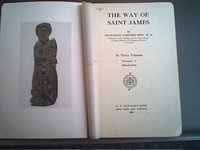
I.
AÑO SANTO 3
II. THE CHURCH OF THE APOSTLE 34
III. DIEGO GELMÍREZ 88
IV. COMPOSTELA 139
V. THE WORLD’S END 202
VI. THE PARADISE OF SOULS 221
VII. THE ASIAN GOD 278
BOOK FOUR: HOMEWARD band 3I. SUMMING OP 373
II.
MA CALEBASSE, C’EST MA COMPAGNE 417
III. THE TWO ROADS 428
Nu volgt van
band 1 de index; deze vormt een uitbreiding van wat hierboven staat.
***********************************************************************************
KB-NUMMER 1927-9-K-141 / 7001 280902 8
band 1: ± 416 pagina's
*********************************************************************************** iii-ix FOREWORD - G.G. King. Bryn Mawr, All Souls’ Day, 1917
xiii
BOOK ONE: THE PILGRIMAGE band 1 Chapter:
I. INTENTIONS 3
II. TURPIN’S CHRONICLE 26
III. THE BOOK OF S. JAMES 41
IV. THE STATIONS OF THE WAY 64
V.
ROMEROS EN ROMERÍA 93
BOOK TWO: THE WAY band 1I. SETTING OUT 137
II. HEART OF ARAGON 152
Jaca: The Cathedral 157
S. Juan de la Peña 165
Alfonso el Batallador 192
III. THE BATHS OF TIERMAS 202
Leyre 210
Sangüesa 230
IV. PAMPELUNA 253
V. SAINT SEPULCHRE 286
Puente La Reyna 294
El Sepulchro 309
VI. TOWN CHURCHES 324
Irache 357
VII. THE LOGROÑO ROAD 366
The Spires of Logroño 370
Along the Battlefield 381
S. Mary the Royal 394
VIII. TWO ROAD-MENDERS 406
Sieurs des Orties 431
NOTES 441
XV ILLUSTRATIONS
SANTIAGO MAYOR FronticpieceS. JAMES: FROM BERRUGUETE’S TOMB OF CARDINAL TAVERA 51
THE SOUL AS PILGRIM
From a miniature of the Xvth century 125
THE CREST OF THE PYRENEES
Photogravure139
A PYRENEAN VILLAGE 149
S. JAMES AND PILGRIM: FROM S. CERNÍN 179
EUNATE
Photogravure 231
THE QUEEN’S BRIDGE
Photogravure 286
EL SEPULCRO 311
BOOK 1-1 THE PILGRIMAGE 3
I. INTENTIONS (3 58-63 72-3 80-92) * (zie noot onderaan)
V.
ROMEROS EN ROMERÍA 93 (93-7 102-124 130-4)
BOOK 1-2 (TWO) THE WAY 135
I. SETTING OUT 137 (137-141 222-3 240-1 292-3)
Puenta la Reyna 294 (294-5 308)
El Sepulcro 309 (309-311 314-317 358-9 364-5 372-373 398-9 408-9 412-3 426-9 436-9)
NOTESCHAPTER IV 446-8
CHAPTER V 448-460
The Spires of Logroño 460
Along the Battlefield 460
S. Mary the Royal 461
Chapter VII 461
***********************************************************************************
KB-NUMMER 1927-9-K-142 / 7001 280903 X
band 2: ± 514 pagina’s; subtotaaal = 516+514=1030)
***********************************************************************************
iii CONTENTS
BOOK TWO: THE WAY (Continued) band 2 Chapter:
IX.
CAPUT CASTELLAE 3
Las Huelgas 10
The Cathedral 29
Strangers and Pilgrims 60
X. THE FORDS OF CARRION 71
Villalcázar de Sirga 84
Carrión de los Condes 96
Benevívere 112
XI. SAHAGÚN 118
Sepultados 151
S. Pedro de las Dueñas 160
The Pilgrim Turns Aside to S. Miguel de Escalada 165
XII.
PULCHRA LEONINA 175
S. Isidore 186
iv Doctor Egregius 214
Leon the Fair 238
XIII. THE HEATH AND THE PASS 278
Astorga 293
The Port of Rabanal 238
XIV. THE PASSAGE HONOURABLE 317
XV. IN THE VIERZO 349
Cacabelos 361
Villafranca 367
XVI. BY SIL AND MIÑO 381
The River Road 382
In Galicia 410
The Unknown Church 425
Whinny Moor 461
Mountjoy 480
493 v ILLUSTRATIONS
S. JAMES
Frontispiece (
From the painting by El Greco)
BRIDGE OVER THE PORMA 45
BENEVÍVERE
Photogravure114
A PILGRIM IN BLACK-LETTER 157
THE CHURCH AT ORBIGO
Photogravure204
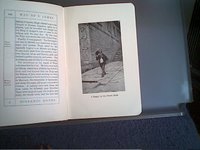
A LITTLE TOWN IN LEON 235
THE PASS OF RABANAL 285
THE BRIDGE OF ORBIGO 327
THE MOUNTAIN OF THE VIERZO
Photogravure 354
vi
VEGA DE VALCARCEL 399
A PILGRIM IN JET 445
A PILGRIM IN SANTIAGO 483
BOOK TWO 1 THE WAY (Concluded) band 2 IX CAPUT CASTELLAE (3-9 44-5 68-70) 3
X THE FORDS OF CARRION (71-3 92-5 122-137 156-7 164-5)
The Pilgrim turns aside to S. Miguel de Escalada 165 (165-171 180-186)
S. Isidore (186-194 202-7 220-237 254-265) 186
The Port of Rabanal (304-5 326-7 350-360) 304
Cacabelos (380) 361
XVI BY SIL AND MIÑO (381 410) 381
In Galicia (410-1 420-425) 410
The Unknown Church (425-445 452-5 458-461) 425
Whinny Moor 461
Mountjoy! (480-3 490-2) 480
NOTES: BOOK TWO 493
CHAPTER IX (493 500-1)
CHAPTER XII (502-5) 502
CHAPTER X111 (508-9) 508
CHAPTER XVI (512-4) 512
The River Road 512
In Galicia 513
The Unknown Church 513
Whinny Moor 514
Mountjoy 514
************************************************************************************
KB-NUMMER: 1927-9-K-143 - 7001 280904 1
M eu Spain 99502 king 22.5?
band 3: ± 710 pagina’s (totaal 710+1030=1740 pagina’s in 3 banden)
************************************************************************************iii-v CONTENTS
BOOK THREE: THE BOURNE band 3
CHAPTER:
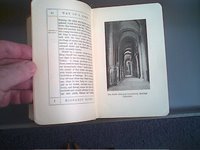
I.
AÑO SANTO 3
II. THE CHURCH OF THE APOSTLE 34
III. DIEGO GELMÍREZ 88
IV. COMPOSTELA 139
The Church of a Dream 163
As Pilgrims Pass 173
Castle and Church 181
Los Muertos Mandan 196
V. THE WORLD’S END 202
VI. THE PARADISE OF SOULS 221
The Long Way 245
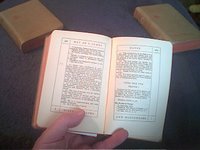
The Singing Souls 253
The Bridge of Dread 259
VII. THE ASIAN GOD 278
The Constant Worship 285
The Star-led Wizards 314
The Mortal Twin 334 [
He is the twin of Christ. - foto]
The High God 347
Along the Eastern Road 365
BOOK FOUR: HOMEWARD band 3 I. SUMMING OP 373
The Chantier 379
Excursus on Some Twelfth Century Sculpture 386
Workmen of S. James 396
Sorting 407
II.
MA CALEBASSE, C’EST MA COMPAGNE 417
III. THE TWO ROADS 428
Ronceveau 449
Envoy 453
NOTES 457
APPENDIX 497
Notes on S. James Major, S. Mary Virgin, and the Pillar at Saragossa 497
Miracles of S. James (AA.SS) 508
Miracles of Our Lady of Villa-Sirga 520
The Great Hymn of S. James 530
The Little Hymn of S. James 553
La Grande Chanson des Pèlerins de S. Jacques 536
Thurkill’s Vision 543
Apocalypse of S. Paul 553
Frau Holde 558
A Lyke-Wake Dirge 560
El Alma en Pena 563
Gallegan Romance 566
Purchas his Pilgrim 568
Itinerairies 576
BIBLIOGRAPHY 621
INDEX 664
vii ILLUSTRATIONS vii
SANTIAGO MATAMORES FrontispieceTHE NORTH AISLE AND AMBULATORY, SANTIAGO
CATHEDRAL 13
THE FOUNTAIN AT SANTIAGO
Photogravure facing page 54
BLUE HYGRANGEAS 77
A BEGGAR BY THE
PUERTA SANCTA 109
PUERTA DE LAS PLATERÍAS 145
THE GREAT STAIR AT LE PUY 205
MASTER MATEO’S PORCH
Photogravure facing page 262
CHRIST AS PILGRIM-FROM SILOS 305
viii
COINS 355
PILGRIM’S CROSS AT MELLÍD 399
FINISTERRE IN THE MIST 439
BOOK THREE THE BOURNE band 3 1
I AÑO SANTO (3-33) 3
II THE CHURCH OF THE APOSTEL (34-87) 34
III DIEGO GELMÍREZ (88-138) 88
IV COMPOSTELLA (139-173) 139
As Pilgrims Pass (173-365) 173
Castle and Church 181
Los Muertos Mandan 196
V THE WORLD’S END 202
The Bridge of Dead 259
VII THE ASIAN GOD 278
The Constant Worship 285
The Star-led Wizards. 314
The Mortal Twins 334
Along the Eastern Road. (173-333 366-370) 365
BOOK FOUR HOMEWARD band 3 371 (371-710)
I SUMMING UP 373
The Portico of Visions 375
The Chantier 379
Excursus on Some Twelfth Century Sculptures 386
Workmen of S. James 396
Sorting 407
II MA CALABASSE, C’EST MA COMPAGNE 417
III THE TWO ROADS 428
Ronceveaux. 449
Envoy. (371-455) 453
NOTES 457
NOTES: BOOK THREE 457
CHAPTER II 457
CHAPTER III 462
CHAPTER IV 463
The Church of a Dream 465
As Pilgrims Pass: 467
Castle and Church 467
CHAPTER V 468
CHAPTER VI 469
The Long Way: 472
The Singing Songs: 472
The Bridge of Dread: 473
CHAPTER VII 475
The Constant Worship: 477
The Mortal Twins: 484
The High God: 486
Along the Eastern Road: (457-488) 487
NOTES: BOOK FOUR
CHAPTER 1 489
The Portico of Visions 489
The Chantier: 490
Excursus on some Twelfth Century Sculpture 490
Workmen of S. James 491
Sorting 491
CHAPTER II 492
CHAPTER III 493
APPENDIX 495
APPENDIX 496
I.
Notes on S. James Major, S. Mary Virgin, and the Pillar, at Saragossa
II. Miracles of S. James (AA.SS)
III. Miracles of Our Lady of Villa-Sirga
IV. The Great Hymn of S. James
V. The Little Hymn of S. James
VI.
La Grande Chanson des Pèlerins de S. JacquesVII. Thurkill’s Vision
VIII. Apocalypse of S. Paul
IX Frau Holde
X. A Lyke-Wake Dirge
XI.
El Alma en PenaXII. Gallegan Romance
XIII. Purchas his Pilgrim
XIV. Itinerairies
I
NOTES ON S. JAMES MAJOR, S. MARY VIRGIN, AND THE PILLAR, AT SARAGOSSA 497
II THE MIRACLES OF S. JAMES 508
III MIRACLES OF OUR LADY OF VILLASIRGA 520
IV THE GREAT HYMNS OF S. JAMES 530
V THE LITTLE HYMN OF S. JAMES 533
VI
LA GRANDE CHANSON DES PÈLERINS DE S. JACQUES 536
VII THURKILL’S VISION (Condensed) 543
VIII FROM THE APOCALYPSE OF PAUL 553
IX FRAU HOLDA 558
X A LYKE-WAKE DIRGE 560
XI
EL ALMA EN PENA 563
XII GALLEGAN ROMANCE 566
XIII PURCHAS HIS PILGRIM 568
XIV ITINERARIES 576
I. ITINERARY OF AYMERY PICAUD 576
II. FROM DE CAUMONT: VOIATGE Á S. JACQUES EN COMPOSTELLE 580
III. LE CHEMIN DE PARIS Á SAINCT-JACQUES EN GALICE DIT COMPOSTELLA; ET COMBIEN IL Y A DE LIEUES DE VILLE EN VILLE 586
IV. REPORTORIO DE TODOS LOS CAMINOS DE ESPAÑA: 589
V. NOVELLE GVIDE DES CHEMINS. 596
VI. PILGRIM’S GUIDE. FROM
CHANSONS DES PÈLERINS DE S. JACQUES. 605
VII. ITINERARIO ESPAÑOL, O GUIA DE CAMPINOS 610
BIBLIOGRAPHY 619
INDEX 663
(371-710)
* De tussen (.) aangeduide pagina's zijn in kopie aanwezig.
---------
[citaat uit
The Way of Saint James van Georgiana Goddard King:]
FOREWORDDuring my stay in Rome of two years and a half, I employed all the spare time I had from Books and Libraries in viewing the Monuments; and I at last prescribed to myself a certain Method in making my Observations so as to go through the whole City in twenty Days. This same I repeated as often as either at the Request of my Friends or for my own Satisfaction I surveyed the city, always allotting twenty Days to review the whole. -- Père Montfaucon.
FOLLOWING the precedent of the learned Benedictine, I have made one straight story out of three years' wanderings, and places visited and revisited. The outcome offers, first, a record of what exists, where other accounts are incomplete or inaccessible, and, secondly, an explanation of it. Spain is a long way off, and pictures are not always explicit. It has taken seven years of my life. The writer's contribution, in particular, is first, a record and inter

pretation of iconographic detail all along the way, e. g., at Leyre from observation, at Santiago from Aymery Picaud's account; second, an attempt to date, by comparison with such dated examples as exist, without any à priori; third and last, an occasional small hypothesis and the ground for it, e. g., about the original west front at Compostella, and the cult of Santiago. The general intention is stated at length in the first chapter; briefly, it was to discover and record the evidence of Spain's debt in architecture to other countries, France in especial, during the Middle Age. By contrast with the French style which came in along the Camino francés, it was necessary to define the Spanish styles which that supplanted or modified, and was swallowed up in at last: this must justify the consideration given twice or thrice to earlier churches on sites now occupied, especially to the earlier sanctuaries of the Apostle. At Leon Sr. Lampérez had already made such a study. The intention being to supplement his work and Street's great book, not to compete with them, repetition of what Street had published is avoided and, in consequence, only a single aspect of each of the great cathedrals can figure here. To deal adequately with any one, would want a book at least as large as this.
[Drawing from Street’s book; see http://king-early-days.blogspot.com & http://king-renaissance.blogspot.com –gb]
For those who desire to
secure facts while avoiding the context, a very careful Index is supplied. This makes it possible for the learned to look up a church unmolested by the dust of the highway, and even the learned may care to look into the pages for some of the churches which are, so far as may be ascertained, hitherto unpublished: of these are Torres, Barbadelo, Puerto Marin. The writer has looked into a good many old books and not a few remote and distinguished periodicals. The excursus into what may seem the field of comparative literature, indispensable to the argument, was long, laborious, and scrupulously at first hand. The religions of the Roman Empire were investigated in competent and first-rate authorities, which are enumerated in the bibliography. Cursor Mundi is cited so often, though an English work, because it is precisely what it calls itself, a Pilgrim of the World, that has gathered up an immense quantity of current and floating lore, and represents just what might be in the head of any stonecutter or master of the works. It is a popular and plebian substitute for Vincent and Honorius. The Bibliography represents not the books consulted but those which yielded matter of worth, -- a very small proportion. In the Appendix are printed a few pièces juslificatifs: quotations in verse or others too long for a footnote; the Grande Chanson des Pèlerins, the Great and the Little Hymn of S. James and his Miracles out of the Acta Sanctorum, the Miracles of our Lady of Villa-Sirga out of the Cantigas del Rey Sabio, Thurkill's Vision, and a selection of Itineraries for the curious stay-at-home.
Possibly it will be said that this little book is neither one thing nor the other, for it offers
archaeology without jargon, and travel without flippancy. The writer's hope is that the learning, however small, may be judged sound, and the style not unworthy of it in being the ordinary vehicle, which is the daily speech of cultivated people: and that some worth and some pleasure may consist in the
exact account of what was done and seen with the sense and in the light of a whole history and literature yet palpable and precious, though less familiar to the gentle reader than the immortal ambience of the Lombard plain and the hill-towns of Tuscany. To pay the gratitude I owe to all who have helped me would take too long a list: it would begin with the great S. James himself, with the good Companion of many days, with a great and generous lover of Spain; and end with the long suffering guardians of books in many libraries, the good-tempered boys and girls who fetched and carried dusty piles, and the outraged librarians who despatched too many tiresome loans by post. Some names however may not be omitted, nor may I leave unsaid my thanks, for untiring and learned assistance, to the Reverend Father Middleton of Villanova College, who has answered questions intricate and importunate; to Dr. Wright and Dr. Patch of Bryn Mawr College, who have read a number of chapters in manuscript, and bettered them, and Dr. Frank and Dr. Barton who have answered demands sudden and surprising; to D. Juan Agapito y Revilla, the Vallasoletan architect and ecclesiologist, for precious time spared to me and the gift of publications, some otherwise unattainable; to my friend D. Angel del Castillo of Corunna for other articles and specific advice and instruction simply invaluable; to D. Benito Fernández Alonso, of the Commission of Historic Monuments in Orense, for many courtesies and gifts; also to Mgr. Ragonesi, the Apostolic Nuncio in Spain; to the Archbishops of Santiago and Burgos and the Bishop of Leon; to the Dean and Chapter ef Santiago and the Abbess of Las Huelgas; to the Canónigo Fabriquero of Mondoñedo and the Canónigo Archivero of Santiago, and D. Felix Ararás, Canónigo Magistral of Burgos: and to twoscore parish priests who without a single exception offered me of their best,
from erudition down to new milk, to the glory, in the grand phrase of one of them -- to the glory of religion and of Spain.
G. King. BRYN MAWR, All Souls' Day, 1917.
The illustrations are taken in part from old books and museum pieces, in part from coins, and I have to thank G. F. Hill, of the British Museum, for a generous gift of casts from some coins in that collection; in part also from photographs of my own, and others, better, of E. H. Lowber. For drawings of difficult matter I am greatly indebted to Miss Helen Fernald, Instructor in the History of Art at Bryn Mawr College.
To the Curator of Publications at the Hispanic Society, Miss Isabel K. Macdermott, the reader owes as much as the writer, for her long patience and vigilant oversight during the publication. For the use in Spanish words, names, and titles, she and I are responsible, jointly, but it seems desirable that I should explain the principles to which we conformed; Spanish names of persons and places, and titles of modern books, are spelled and accented in accordance with the latest rulings of the Spanish Academy; the titles of old books are given as the author gave them. But it is a proud truth that the relations between those of English and those of Spanish speech were not established yesterday, nor even during the Peninsular War, but are a part of the ancient heritage of the two nations, and the sign thereof is that
Spanish places have English names. We speak of Seville and Corunna, Pampeluna and Saragossa, Castile and Leon, by the same token that Shakespeare wrote of Katharine of Aragon, and Southey of the Infants of Carrion rhyming to Robin Hood's Marion. Those names I have used as we say Venice, Rome, and Florence, Paris, Lyons and Marseilles. They are each a token and a pledge that insularity is merely geographical and not intellectual, that isolation on the other side of the world cannot cut off Americans from talking in free and homely speech of the great places to which they turn with ancestral love and longing. In referring to Kings and Queens of the Spains, and other saints or heroes, I have not been careful always to call them by the same name, but as Jack and Jill may be addressed as John and Joan at times, I have taken the liberties that old acquaintance allowed. To call Isabel the Catholic Elizabeth, or the English Tudor the Isabellan style (though others have done it), I should hold for presumption, but Ferdinand and Alfonso may alternate methinks with Fernando and Alonso when the chronicler or the hagiographer prompts, and S. James is still recognizable as Santiago.
This is not meticulous nor pedantic, but it is comfortable and easy, which is a great good in travel. [red highlighting by gb] G. G. K.
CONTENTS
BOOK ONE: THE PILGRIMAGE
INTENTIONS
TURPIN’S CHRONICLE
THE BOOK OF S. JAMES
THE STATIONS OF THE WAY
ROMEROS EN ROMERÍA
BOOK TWO: THE WAY
SETTING OUT
HEART OF ARAGON
Jaea: The Cathedral
S. Juan de la Pefia
Alfonso el Batallador
THE BATHS OF TIERMAS
Leyre
Sangüesa
PAMPELUNA
SAINT SEPULCHRE
Puente la Reyna
El Sepulcro
TOWN CHURCHES
Irache
THE LOGROIRO ROAD
The Spires of Logroño
Along the Battlefield
S. Mary the Royal
TWO ROAD-MENDERS
Sieur des Orties
NOTES
Doel van al deze King-besprekingen is ooit een betaalbare vertaalde dundruk, opdat iedere pelgrim onderweg beter leert kijken naar wat hij ziet. Inmiddels is er een
complete herdruk van alle drie Volumes als pocketbook; zie
http://pilgrimsplaza.blogspot.com.
********************************************************
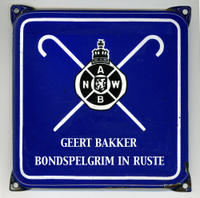 Alle © rechten voorbehouden!
Alle © rechten voorbehouden!
Home website PILGRIMSPLAZA:
www.pelgrimspaden.nl Home phpBB-forum:
http://pelgrimspaden.blogspot.com

 © Alle King-weblogs over The Way of Saint James van Georgiana Goddard King bijelkaar: http://king-early-days.blogspot.com © http://king-renaissance.blogspot.com © http://pilgrimsplaza-king-index.blogspot.com © http://pilgrimsplaza-king-0.blogspot.com © http://pilgrimsplaza-king-1.blogspot.com © http://pilgrimsplaza-traplepuy.blogspot.com © http://pilgrimsplaza-king3.blogspot.com © diversen: http://pilgrimsplaza-ramiro-1.blogspot.com © http://pilgrimsplaza-peterspruijt.blogspot.com © http://seculierpelgrimsgenootschap.blogspot.com © http://pilgrimsplaza-gedichten.blogspot.com © http://pilgrimsplaza-boeken.blogspot.com ©
© Alle King-weblogs over The Way of Saint James van Georgiana Goddard King bijelkaar: http://king-early-days.blogspot.com © http://king-renaissance.blogspot.com © http://pilgrimsplaza-king-index.blogspot.com © http://pilgrimsplaza-king-0.blogspot.com © http://pilgrimsplaza-king-1.blogspot.com © http://pilgrimsplaza-traplepuy.blogspot.com © http://pilgrimsplaza-king3.blogspot.com © diversen: http://pilgrimsplaza-ramiro-1.blogspot.com © http://pilgrimsplaza-peterspruijt.blogspot.com © http://seculierpelgrimsgenootschap.blogspot.com © http://pilgrimsplaza-gedichten.blogspot.com © http://pilgrimsplaza-boeken.blogspot.com ©  All these faces are cut out of pictures of the plaster copy in the Victoria & Albert Museum at London of the Pórtico de la Gloria in Saint James's cathedral at Santiago de Compostela in Spain. Courtesy and © (permission given on 22-5-9) of Mr. Gareth Thomas who took al of these photos on the eve of his pilgrimage from England through France to Santiago. Also see http://www.youtube.com/watch?v=Yz_kusZqrLQ .
All these faces are cut out of pictures of the plaster copy in the Victoria & Albert Museum at London of the Pórtico de la Gloria in Saint James's cathedral at Santiago de Compostela in Spain. Courtesy and © (permission given on 22-5-9) of Mr. Gareth Thomas who took al of these photos on the eve of his pilgrimage from England through France to Santiago. Also see http://www.youtube.com/watch?v=Yz_kusZqrLQ .  You may read more about the making of these pictures and Gareth's pilgrimage in Re: The Santiago Enigma by Gareth Thomas on March 29th, 2008, 11:37 pm on http://www.pilgrimage-to-santiago.com/board/miscellaneous-about-santiago/topic3794.html#p20890 .
You may read more about the making of these pictures and Gareth's pilgrimage in Re: The Santiago Enigma by Gareth Thomas on March 29th, 2008, 11:37 pm on http://www.pilgrimage-to-santiago.com/board/miscellaneous-about-santiago/topic3794.html#p20890 .![]() by PILGRIMSPLAZA on March 21st, 2008, 6:00 pm op http://www.pilgrimage-to-santiago.com/board/miscellaneous-about-santiago/topic3794.html
by PILGRIMSPLAZA on March 21st, 2008, 6:00 pm op http://www.pilgrimage-to-santiago.com/board/miscellaneous-about-santiago/topic3794.html  News! 'King' herdrukt (foto)
News! 'King' herdrukt (foto)![]() by Priscillian op http://www.pilgrimage-to-santiago.com/board/miscellaneous-topics/topic3554.html#p18832 . Ook een mooi geschreven boek!
by Priscillian op http://www.pilgrimage-to-santiago.com/board/miscellaneous-topics/topic3554.html#p18832 . Ook een mooi geschreven boek! American pilgrims 2007 (!)
American pilgrims 2007 (!)
 R. A. Fletcher, Saint James's Catapult: The Life and Times of Diego Gelmírez of Santiago de Compostela
R. A. Fletcher, Saint James's Catapult: The Life and Times of Diego Gelmírez of Santiago de Compostela  For the first time, more foreign pilgrims [in Santiago de Compostela]
For the first time, more foreign pilgrims [in Santiago de Compostela] Nieuws: 'King' is in de VS herdrukt als pocketbook en ook de eerste druk uit 1920 (foto) is nog verkrijgbaar! Mijn zending deed er nog geen week over. Iedereen kan nu dit verbijsterende en ontroerende meesterwerk op de eigen pc lezen en kopiëren. Doe mee aan de bespreking en meld u aan in het reactieformulier onderaan deze pagina.
Nieuws: 'King' is in de VS herdrukt als pocketbook en ook de eerste druk uit 1920 (foto) is nog verkrijgbaar! Mijn zending deed er nog geen week over. Iedereen kan nu dit verbijsterende en ontroerende meesterwerk op de eigen pc lezen en kopiëren. Doe mee aan de bespreking en meld u aan in het reactieformulier onderaan deze pagina.
 Het werk bestaat uit (foto) drie aparte in een linnen omslag ingebonden banden, elk iets groter dan een pocketbook, maar toch passend in de binnenzak. Deze 3 banden omvatten samen 31 hoofdstukken in samen 4 boeken (BOOKS).
Het werk bestaat uit (foto) drie aparte in een linnen omslag ingebonden banden, elk iets groter dan een pocketbook, maar toch passend in de binnenzak. Deze 3 banden omvatten samen 31 hoofdstukken in samen 4 boeken (BOOKS).
 IX. CAPUT CASTELLAE 3
IX. CAPUT CASTELLAE 3 I. AÑO SANTO 3
I. AÑO SANTO 3
 I. AÑO SANTO 3
I. AÑO SANTO 3 The Singing Souls 253
The Singing Souls 253 pretation of iconographic detail all along the way, e. g., at Leyre from observation, at Santiago from Aymery Picaud's account; second, an attempt to date, by comparison with such dated examples as exist, without any à priori; third and last, an occasional small hypothesis and the ground for it, e. g., about the original west front at Compostella, and the cult of Santiago. The general intention is stated at length in the first chapter; briefly, it was to discover and record the evidence of Spain's debt in architecture to other countries, France in especial, during the Middle Age. By contrast with the French style which came in along the Camino francés, it was necessary to define the Spanish styles which that supplanted or modified, and was swallowed up in at last: this must justify the consideration given twice or thrice to earlier churches on sites now occupied, especially to the earlier sanctuaries of the Apostle. At Leon Sr. Lampérez had already made such a study. The intention being to supplement his work and Street's great book, not to compete with them, repetition of what Street had published is avoided and, in consequence, only a single aspect of each of the great cathedrals can figure here. To deal adequately with any one, would want a book at least as large as this. [Drawing from Street’s book; see http://king-early-days.blogspot.com & http://king-renaissance.blogspot.com –gb]
pretation of iconographic detail all along the way, e. g., at Leyre from observation, at Santiago from Aymery Picaud's account; second, an attempt to date, by comparison with such dated examples as exist, without any à priori; third and last, an occasional small hypothesis and the ground for it, e. g., about the original west front at Compostella, and the cult of Santiago. The general intention is stated at length in the first chapter; briefly, it was to discover and record the evidence of Spain's debt in architecture to other countries, France in especial, during the Middle Age. By contrast with the French style which came in along the Camino francés, it was necessary to define the Spanish styles which that supplanted or modified, and was swallowed up in at last: this must justify the consideration given twice or thrice to earlier churches on sites now occupied, especially to the earlier sanctuaries of the Apostle. At Leon Sr. Lampérez had already made such a study. The intention being to supplement his work and Street's great book, not to compete with them, repetition of what Street had published is avoided and, in consequence, only a single aspect of each of the great cathedrals can figure here. To deal adequately with any one, would want a book at least as large as this. [Drawing from Street’s book; see http://king-early-days.blogspot.com & http://king-renaissance.blogspot.com –gb]